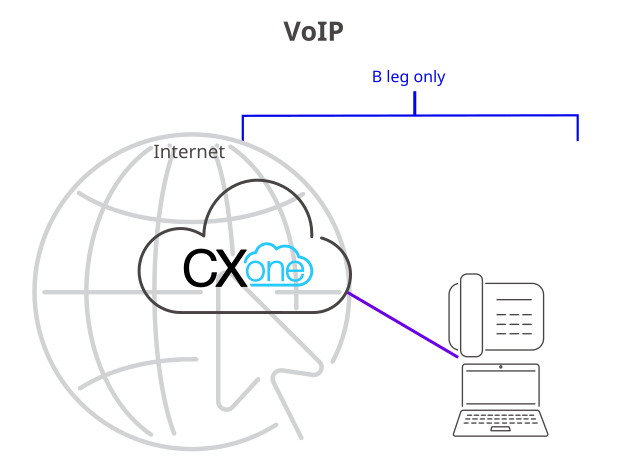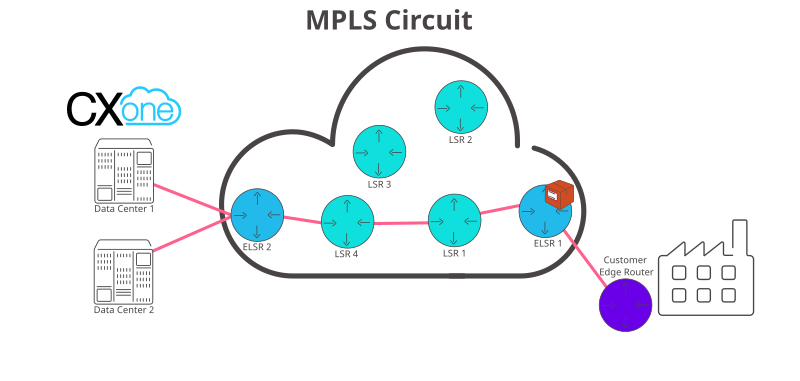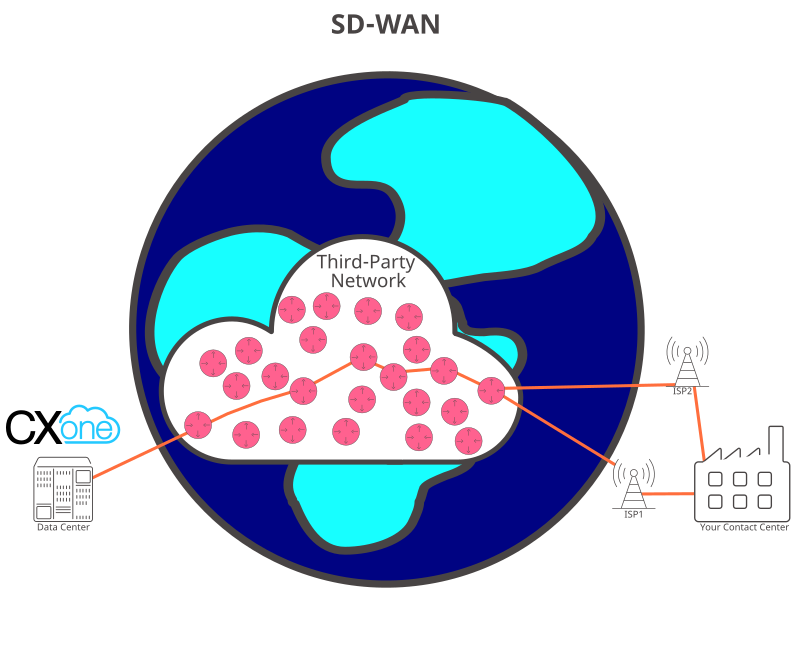This page describes general concepts of telephony. It also takes a look at how these concepts work in a CXone Mpower contact center and the advantages and disadvantages of using each one. If you need help determining the best setup for voice interactions in your contact center, contact your Account Representative.
Transport Options
There are a few ways phone calls can travel from one party to the other. This table explains what these are, how they work with CXone Mpower, and the advantages and disadvantages for using each one.
PSTN
Public Switch Telephone Network (PSTN) is the traditional method for routing voice phone calls. It relies on copper wires, and each call is managed by the central offices, or switching centers, of individual telephone networks around the world. Wired phones and many mobile phones rely on this transport method to make and receive calls.
PSTN in CXone Mpower
PSTN can carry the call through both the A and B leg. An inbound call to a CXone Mpower-powered contact center looks like this:

A leg:
- The contact initiates the call and their telephone set converts analog sound waves into electric signals.
- Electrical signals are transmitted to the local central office on a copper wire.
- Electrical signals are converted to digital packets.
- Digital packets are delivered to the CXone Mpower platform.
B Leg:
- CXone Mpower initiates the outbound call by delivering digital packets to the receiving central office.
- The digital packets are converted back to electrical signals.
- The electrical signals are routed to the agent.
- The agent's telephone set converts the electrical signals back into analog sound waves.
Pros
-
Quick and easy to set up since the facilities are already in place.
Cons
- Potential for expensive per-minute billing
- There are multiple carriers to work through, making orders and repairs more time-consuming
- Susceptible to static
CXone Mpower classifies any traffic routed using DID (Direct Inward Dialing) and TFN (toll-free number) as PSTN. This is true even if the call is delivered to a mobile phone or the contact is using a digital phone like Vonage or Comcast.
VoIP
Voice over Internet Protocol (VoIP) is internet-based voice transmission. It requires a computer with a softphone application or a VoIP-enabled polycom hard phone. VoIP converts analog sound waves into many small digital packets of binary code. The smaller packets of data make the data easier and faster to transmit. A single packet consists of:
- Payload: The voice data, which is the binary code version of part of the voice transmission.
- IP header: Contains the source and destination IP addresses of the call.
- UDP (User Datagram Protocol) header: Speeds up transmissions so the conversation can happen in real time.
- RTP (Real-Time Transport Protocol) header: Contains a reliability sequence number that ensures the digital packets are delivered in the correct order.
VoIP in CXone Mpower
Softphone is the CXone Mpower VoIP product. It can transport CXone Mpower calls on the B leg only. However, some CXone Mpower UCaas partners allow you to use VoIP for both the A and B leg of a call. The following image shows how VoIP works in a CXone Mpower system. The VoIP-enabled device or computer exchanges digital packets with the CXone Mpower platform over the internet.

Pros
- Low cost
- Agents can work anywhere with internet access
- Many additional features can be used with VoIP
Cons
-
Susceptible to latency (jitter) and packet loss. This can lead to audio distortion or dropped calls.
You can reduce these issues by routing VoIP over dedicated connections like MPLS and SD-WAN.
Integrated Softphone
One of most common connectivity configurations for agent leg traffic. It uses the WebRTC feature in the agent's Chrome browser to transmit voice data. The agent application handles it all; It doesn't required a locally-installed application or pseudo numbers.
Integrated Softphone in CXone Mpower
Pros
- No equipment required
- Fast and easy to deploy
- No additional CXone Mpower fees
Cons
-
Susceptible to latency (jitter) and packet loss. This can lead to audio distortion or dropped calls.
You can reduce these issues by routing VoIP over dedicated connections like MPLS and SD-WAN.
- CXone Mpower has a limited view into it, which makes problems difficult to troubleshoot
Best practice is to route agent WebRTC traffic directly to the CXone Mpowerplatform over the internet without going through a corporate network. This is because:
- WebRTC can be negatively impacted by the performance, configuration, or browser of the agent's local machine.
- WebRTC protocol can be sensitive if you route agent audio over a corporate WAN.
- Devices like proxy servers and firewalls can block or disrupt portions of signaling, leading to packet loss and sound quality issues.
VoIP Technologies
This section describes technologies you can use to transport your call data over an IP. It also describes how they work in a CXone Mpower contact center.
SIP
When you exchange data over an IP (Internet Protocol), two types of IP packets are used:
-
Signaling packets: Set up, maintain, and end the sessions.
-
Media packets: Contain the audio, video, and application data exchanged in a session.
Session Initiation Protocol (SIP) is a method that you can use to exchange voice data over an IP. It enables the devices in a VoIP call transmission, including WebRTC, to communicate with each other. It's a shared language that devices can use to exchange data, regardless of the differences in internal processes, structure, or design between the devices.
SIP in CXone Mpower
You can use SIP for voice interactions on the CXone Mpower A or B leg if you have locally installed, SIP-enabled telephony equipment. You can use SIP on MPLS, internet, and SD_WAN.
Pros
-
Agents can use the physical equipment they're already familiar with.
Cons
-
SIP signaling can be complex. CXone Mpower uses Empirix to help isolate SIP signaling into the different commands. This helps to identify call issues related to dropped packets or improper SIP signaling.
CODEC
Coder/Decoder (CODEC) compresses and decompresses digital media as it's being transmitted, especially for audio and video data that take a lot of bandwidth. CODEC is required to transport audio data during VoIP-powered calls, including WebRTC. CODEC lets you place more calls on the same bandwidth.
CODEC in CXone Mpower
CXone Mpower supports two options:
-
G.711: 88 Kbps (higher quality)
-
G.729: 33 Kbps (lower quality). You may want to use G.729 if you have equipment or bandwidth constraints, if you want to stack more calls on the transport, or if your equipment can only transcode G.729.
MPLS
In a non-MPLS circuit, the packets go through a series of routers, with each router looking at the destination IP address and passing it to the next router on the way to the destination. Each router decides where the packet should go next.
Multiprotocol Label Switching (MPLS), by contrast, has the first router check the destination IP address on the packet and then determine the shortest route. It applies a label to the packet with the determined route. Each router on the path checks the label and sends the packet to the next router in the path without checking the destination IP address. The last router in the path removes the label before delivering it. This process is faster and more efficient than non-MPLS circuits.
MPLS involves two types of routers:
-
LSR (Label Switch Router): Route packets across provider's network
-
ELSR (Edge Label Switch Router): Opens the packet, checks its destination IP address, and charts the entire path to the distant end. ELSRs can also be part of the path to route packets across the provider's network.
MPLS in CXone Mpower
The following image shows how MPLS works for an inbound call in a CXone Mpower contact center. When a contact places a call, the digital voice packets go from the contact's edge router, shown on right side of the image, into the MPLS circuit. ELSR 1, the nearest ELSR router, receives a packet from the contact, looks at the destination IP address, and charts the shortest route through the routers to the CXone Mpower platform. This image shows that particular step: the labeled box on the ELSR 1 router represents the packet with a label attached.
The packet follows the charted path. When they receive the packet, LSR 1, LSR 4, and ELSR 2 each look at the label to determine where to send the packet next. ELSR 2, the final router in the path, takes the label off the packet before delivering it to the CXone Mpower platform. In this case, the final router happens to be another ELSR, but a route can also end with an LSR. ELSR 2 sends the packet to the two CXone Mpower data centers nearest to your contact center.

MPLS can transport data from different technologies and protocols, including IP (ATM, Frame Relay), SONET, and Ethernet. MPLS circuits are usually deployed in pairs to allow for redundant routing from your premise PBX location to both data centers in whatever region your call center resides. You can use MPLS to carry VOIP and WebRTC traffic, but for CXone Mpower it's most commonly used for SIP-style telephony routing.
Pros
-
Controlling the packet path reduces latency
-
The dedicated path provides greater security than the open internet
-
QoS methodology. You can specify which types of processes take priority on your network. For example, in your CXone Mpower system, you would want to prioritize voice over web processes.
Cons
-
Adding bandwidth on MPLS can be difficult. If you are interested in implementing an MPLS circuit, contact your Account Representative. They will have the CXone Mpower Connectivity Team work with you to ensure you have sufficient bandwidth for your current traffic and anticipated growth so you don't have to add bandwidth later.
SD-WAN
A Wide Area Network (WAN) is a network that spans a large area. The internet is the largest WAN. The challenge with using the internet to route calls is that, once a call hits the open internet, it can take any route to hit its destination. You have no control over path. It often results in latency, packets delivered out of order, and lost packets.
SD-WAN is a WAN that's limited by software. This makes voice data delivery faster and more secure than transporting over the open internet.
SD-WAN in CXone Mpower
SD-WAN is a WAN defined by both software and a third-party network. The third-party network can direct calls using most efficient route and drop it to the point closest to your ISP (Internet Service Provider). To operate at the highest level, you need two ISPs terminating at your place of service. You can still use SD-WAN with one ISP, but the performance will suffer.
The following image shows an inbound voice call moving from the CXone Mpower platform to the customer contact center for an agent to handle. The call takes the shortest path possible through the third-party network for fast delivery.

SD-WAN is only used for voice communications between the contact and the contact center. Your agents would still use the agent application over the internet. SD-WAN is most often paired with SIP, but it can also transport VoIP and WebRTC.

